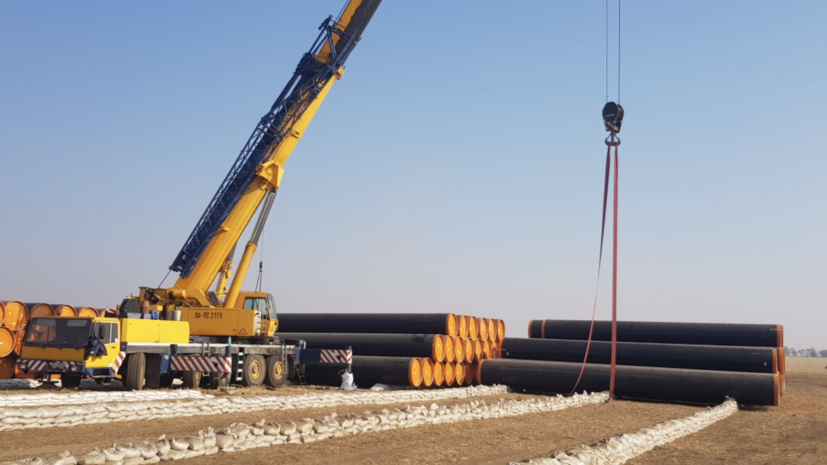Serbian leader Aleksandar Vucic launched the Balkan Stream gas pipeline in Serbia.
This is a highway that is a continuation of the Turkish Stream.
Speaking at the ceremony, Vucic noted the importance of the launch of the Balkan Stream, adding that "Serbia has become much richer after the gas was connected."
"The price for 1 thousand cubic meters will be $ 155 at the entrance from Bulgaria, plus from $ 12 to $ 14 transportation costs in our network, previously it was $ 240", - said Vucic.
The Serbian President added that the gas pipeline will provide an inflow of investors to different regions of the country.
“We have a lot of work to do to develop the secondary network, but this gives us hope for a bright future.
Gas will go through our network to Hungary.
Happy New Year!
Thanks to the President of Russia, ”said Vucic.
The ceremony was also attended by the Russian Ambassador to Serbia, Alexander Botan-Kharchenko.
He called the launch of the gas pipeline "a New Year's gift" and one of the largest projects of Russian-Serbian cooperation.
“The project will ensure the stability of Serbia, will enable further development of internal infrastructure and transportation.
Serbia will become even more attractive for investments and a transit country, which gives more opportunities, ”the diplomat emphasized.
The management of the Serbijagas company also announced that in the near future the construction of internal and regional highways in the country will begin, including the Belgrade - Banja Luka and Belgrade - Valjevo directions.
Recall that the Turkish Stream, which is a continuation of the Balkan Stream, was inaugurated on January 8, 2020 with the participation of Presidents Vladimir Putin and Recep Tayyip Erdogan.
Within the framework of the Turkish Stream project, two lines of the gas pipeline were built, one of which is intended for the Turkish market, the second for the European one.
The design capacity of the pipeline is 31.5 billion cubic meters of gas per year.
To gallery page
The gas pipeline runs along the bottom of the Black Sea from Russian territory to the Turkish coast, and then along a land transit line to the Turkish border with neighboring countries.
The length of the pipeline section opened in Serbia is 403 km, and the design capacity is 13.9 billion cubic meters of gas per year.
The company - the operator of the Gastrans pipeline, reported that the connecting Bulgaria-Hungary gas pipeline passing through Serbia, in the second half of 2021, after being connected to the Hungarian GTS, will be able to pass 12.87 billion cubic meters of gas that comes to Bulgaria from the Turkish Stream.
“At the first stage, the gas pipeline will transport about 4 billion cubic meters of gas a year, which will fully cover Serbia's natural gas needs.
By the fourth quarter of 2021, after the gas pipeline is connected to the Hungarian gas transmission system, the throughput capacity of the gas pipeline will be 12.87 billion cubic meters of gas per year, "RIA Novosti quotes the company's message.
It is also noted that the project, even at the construction stage, provided more than 2.5 thousand new jobs in Serbia.
Gazprom confirmed the start of gas supplies via the new route.
The company said that today the transportation of gas to Serbia, as well as to Bosnia and Herzegovina, has begun via a new route - through the territories of Turkey and Bulgaria.
“From Russia, gas is transported via the Turkish Stream offshore gas pipeline and further through Turkey.
Then it goes to Serbia via the national gas transmission system of Bulgaria.
Here, gas is distributed and supplied to consumers in Serbia and Bosnia and Herzegovina, ”Gazprom explained.
It is noted that deliveries along the new route became possible thanks to the expansion and commissioning of new capacities by Bulgartransgaz EAD in Bulgaria and GASTRANS doo Novi Sad in Serbia.
The launch was also commented on by the head of "Gazprom" Alexey Miller.
He noted that Turkish Stream is "a modern, efficient and reliable gas pipeline demanded by European consumers."
“The number of European countries that receive Russian gas through the Turkish Stream has grown to six.
Now, along with Bulgaria, Greece, North Macedonia and Romania, Serbia, Bosnia and Herzegovina have provided themselves with such an opportunity, ”Miller concluded.

